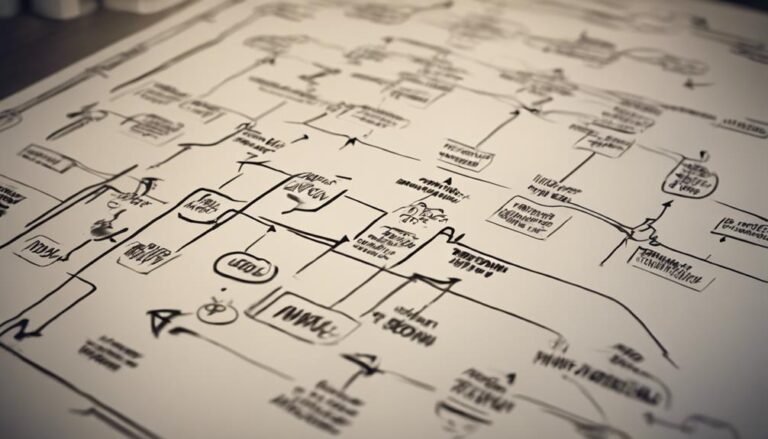Effective Flowcharts for Process Mapping
In the realm of business operations and project management, the use of flowcharts for process mapping has emerged as a crucial tool for enhancing organizational efficiency and clarity in workflows. By visually representing complex processes and decision points, flowcharts provide a structured framework for analyzing, optimizing, and communicating procedures within a team or across departments.
However, the effectiveness of flowcharts is not solely reliant on their creation but also on the strategic selection and implementation of various symbols, design principles, and collaborative practices. As businesses strive for operational excellence and streamlined processes, the role of effective flowcharts cannot be underestimated.
Key Takeaways
- Enhance operational efficiency and clarity through effective flowcharts.
- Identify bottlenecks and inefficiencies for process optimization.
- Facilitate communication and collaboration in workflow mapping.
- Streamline operations and increase productivity with clear process visualization.
Benefits of Flowcharts
The utilization of flowcharts in process mapping offers numerous advantages to organizations seeking to enhance operational efficiency and clarity in workflow visualization. By visually representing processes through flowcharts, businesses can achieve increased productivity and streamlined operations. Flowcharts provide a clear and structured way to document complex processes, making it easier for employees to understand their roles and responsibilities within the workflow. This enhanced clarity helps in identifying bottlenecks, redundancies, or inefficiencies within the processes, allowing for targeted improvements.
Moreover, the visual nature of flowcharts simplifies communication across different departments or teams, ensuring that everyone is on the same page regarding the workflow. This can lead to smoother coordination and collaboration, ultimately contributing to a more efficient operation. Additionally, flowcharts serve as valuable training tools for new employees, enabling them to grasp processes quickly and effectively.
Types of Flowchart Symbols
An essential aspect of process mapping through flowcharts involves the utilization of various symbols to represent different elements within the workflow structure. Symbol identification plays a crucial role in creating effective flowcharts for process visualization. Different symbols convey specific meanings and help in understanding the processes better.
Here are three common types of flowchart symbols used in process mapping:
- Start/End Symbol: This symbol is used to indicate the beginning or end of a process flow. It typically takes the shape of an oval or a rounded rectangle.
- Decision Symbol: Represented by a diamond shape, this symbol is used to indicate a decision point where the flowchart branches into different paths based on a condition.
- Process Symbol: The process symbol, often depicted as a rectangle, is used to represent a task or activity within the process flow.
Best Practices for Flowchart Design
To create effective flowcharts, it is essential to prioritize clear visual representation and logical sequence display. These two key points ensure that the flowchart is easily understandable and can efficiently convey the intended process or system.
Clear Visual Representation
Designing flowcharts with clear visual representation is essential for effectively communicating processes and improving understanding among stakeholders. To achieve this, consider the following best practices:
- Use consistent and easy-to-understand symbols to represent different actions and decisions.
- Maintain proper spacing between elements to avoid clutter and confusion.
- Utilize color coding to emphasize key steps or highlight different process paths.
Moreover, exploring ready-made flowchart templates can further ease the design process by providing a solid foundation for creating structured visual representations adapted to specific needs or practices. These templates not only save time but also assist in maintaining uniformity and consistency across different projects.
Clear visual representation enhances communication by making complex processes easier to follow and comprehend. It simplifies complexity by breaking down intricate workflows into digestible components, aiding stakeholders in grasping the process flow efficiently. By adhering to these practices, flowcharts can serve as powerful tools for streamlining processes and fostering collaboration within an organization.
Logical Sequence Display
For effective flowchart design, ensuring a logical sequence display is paramount to facilitating understanding and coherence among stakeholders. Sequence visualization plays a crucial role in depicting the order of steps in a process, enabling viewers to comprehend the flow of operations easily.
By structuring the flowchart in a logical sequence, from start to finish, it enhances clarity and simplifies complex processes. This approach not only aids in identifying bottlenecks or inefficiencies but also contributes to optimizing process efficiency.
Maintaining a logical flow in the flowchart design ensures that stakeholders can follow the progression of tasks accurately, leading to improved decision-making and streamlined workflows. Therefore, emphasizing a logical sequence display is fundamental in creating effective and informative flowcharts.
Tools for Creating Flowcharts
When it comes to creating flowcharts, the tools used play a critical role in the efficiency and effectiveness of the process. Software options provide a range of features and functionalities that cater to different needs and preferences.
Design elements within these tools allow for customization and clarity in presenting complex processes visually.
Software Options
Among the plethora of tools available for creating flowcharts, selecting the most suitable software can significantly streamline the process mapping exercise. When choosing software options for process mapping, consider the following key features:
- User-Friendly Interfaces: Opt for software that offers intuitive interfaces to facilitate easy navigation and diagram creation.
- Interactive Features: Look for tools that provide interactive elements like clickable buttons or links to enhance the flowchart’s functionality and user engagement.
- Integration with Existing Systems: Choose software that seamlessly integrates with your current systems to ensure smooth data transfer and collaboration.
These features, along with robust data visualization techniques, can enhance the effectiveness of process mapping through flowcharts.
Design Elements
Considering the importance of design elements in creating effective flowcharts, exploring specialized tools tailored for this purpose becomes essential.
Design aesthetics play a crucial role in enhancing the visual appeal and comprehension of flowcharts. Utilizing color coding effectively can help differentiate between various processes or steps, improving clarity and understanding.
When selecting tools for creating flowcharts, it is vital to prioritize features that support design customization, such as the ability to adjust shapes, sizes, and styles. Software programs like Microsoft Visio, Lucidchart, and Creately offer a wide range of design elements to create aesthetically pleasing flowcharts.
Mapping Complex Processes
Mapping complex processes requires a systematic approach to dissect and understand the intricate interplay of various interconnected steps and components. When dealing with intricate workflows, it is essential to employ specific strategies and techniques to ensure clarity and efficiency in the mapping process.
Here are some key aspects to consider:
- Process optimization: Identify areas within the complex process where optimization can be implemented to enhance efficiency and reduce redundancies.
- Decision-making strategies: Develop clear decision points within the flowchart to assist in guiding stakeholders through the process and ensure smooth transitions between steps.
- Problem-solving techniques: Implement problem-solving mechanisms within the flowchart to address potential bottlenecks or issues that may arise during the execution of the process.
Improving Workflow Efficiency
To enhance operational productivity and streamline organizational processes, businesses must focus on optimizing workflow efficiency through strategic analysis and systematic improvements. Increasing productivity and streamlining operations are essential for staying competitive in today’s fast-paced business environment. One way to achieve this is by identifying bottlenecks in the workflow and implementing solutions to eliminate them. This can involve reorganizing tasks, automating repetitive processes, or providing additional training to employees.
Furthermore, utilizing technology can significantly improve workflow efficiency. Implementing project management software, communication tools, or workflow automation systems can help streamline operations and enhance collaboration among team members. Regularly monitoring and evaluating key performance indicators (KPIs) is crucial to identify areas for improvement and track progress towards achieving efficiency goals.
Collaborating Through Flowcharts
How can businesses effectively collaborate through the use of flowcharts to enhance communication and streamline processes?
Flowcharts serve as powerful tools for team collaboration and process visualization. By leveraging flowcharts in a collaborative manner, organizations can achieve improved clarity, efficiency, and alignment within their teams.
Here are three key ways in which businesses can benefit from collaborating through flowcharts:
- Enhanced Communication: Flowcharts provide a visual representation of processes, making it easier for team members to understand complex workflows and communicate effectively. This visual aid can facilitate discussions, clarify responsibilities, and ensure everyone is on the same page.
- Streamlined Processes: Collaborating on flowcharts enables teams to identify bottlenecks, redundancies, or inefficiencies in the workflow. By working together to optimize the process flow, teams can streamline operations and enhance overall productivity.
- Increased Transparency: Through collaborative flowcharting, team members gain visibility into each other’s roles and contributions to the process. This transparency fosters a sense of accountability, encourages teamwork, and promotes a culture of continuous improvement.
Conclusion
In conclusion, flowcharts serve as valuable tools for process mapping, offering a visual representation of complex workflows and aiding in improving efficiency. By utilizing various symbols and design best practices, individuals can effectively communicate and collaborate on process improvement initiatives.
Employing flowcharts can streamline operations and enhance productivity within organizations, making them an essential asset for workflow optimization. Through meticulous planning and implementation, flowcharts can pave the way for enhanced operational effectiveness and success.







